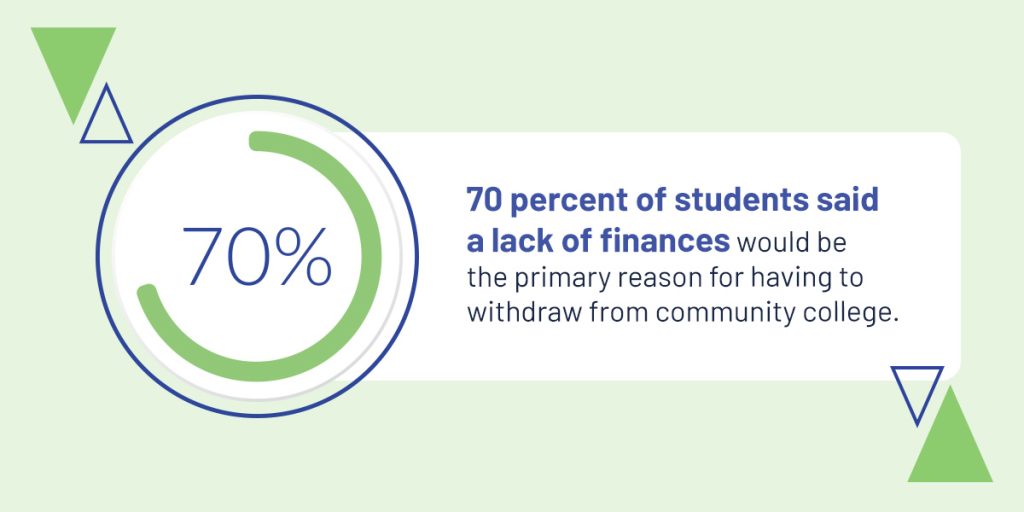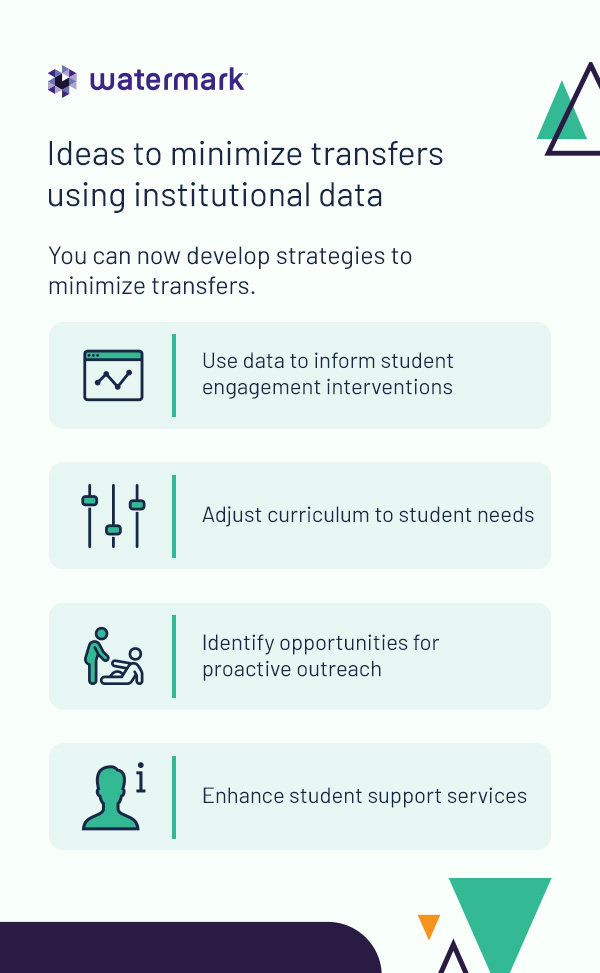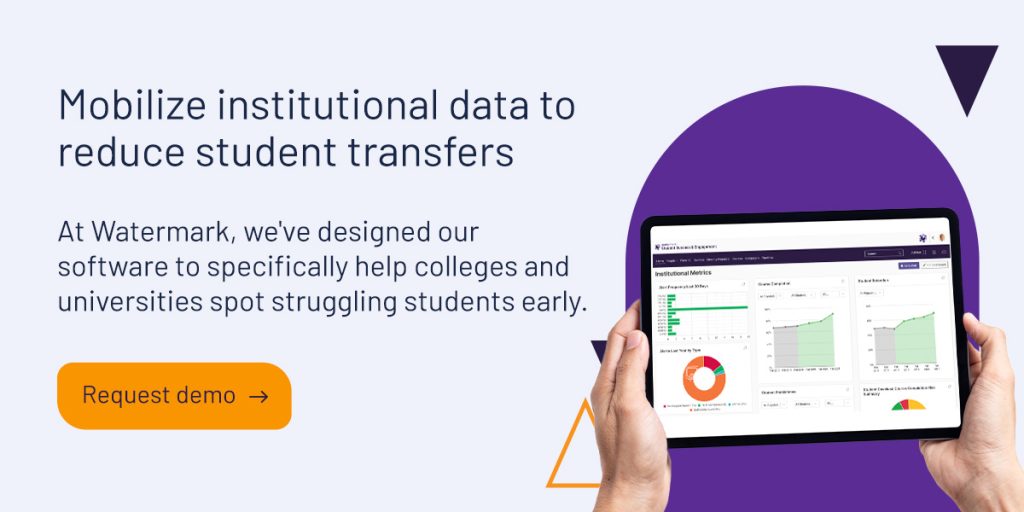




Higher education students come from different backgrounds, which means they can have many reasons for transferring schools while earning their degrees. Though nearly one-third of all students transfer to another school at some point during their academic journey, transfer outcomes have shown little improvement. Research reveals that fewer than 20 percent of students earn their bachelor’s degree within two years of transferring to another institution.
The success rate for lower-income and minority transfer students is nearly half that of their higher-income peers, as only 11 percent of these students will complete their degree within six years. When financial, social, and academic barriers get in the way, many transfer students may decide to put their education on hold and enter the workforce early. Your administration can take advantage of modern tools to gain valuable insights into your student’s needs, empowering you to drive institutional and student success.
Before you can develop and implement effective interventions for struggling students, it’s important to know how to spot the warning signs. Here are the top indicators that learners have disengaged from your institution and plan on transferring.
Motivated students will jump at the first chance to pre-register for the following semester and sign up for their desired classes as soon as possible. Alternatively, those who do not take advantage of pre-registration or do not register for courses at all can be a major sign that they’re unsure if they will return for the next academic term.
Some students may wait until the last minute due to time management or scheduling conflicts. Others prefer to wait for their next academic advising appointment to seek guidance on the amount of credits they should take. Students who fail to register at all can indicate their hesitance in continuing their enrollment, which should be a red flag to administrators of their intention to transfer schools or drop out altogether.
Frequent unexplained or unexcused class absences can demonstrate a student’s lack of engagement with their courses or the institution as a whole. Those who are often tardy or leave the class prematurely may also be at high-risk for transferring. These indicators should be particularly noted early on in the semester, which is often when students are still adjusting to new academic demands and may need intervention or support.
While students can be late or tardy for many perfectly understandable reasons, those who fail to show up consistently should be a priority. Absent students have often disconnected mentally and emotionally from their instructor, program, and schoolwork as a whole by the time they stop showing up for class.

An estimated 20 to 50 percent of students are undecided on their major when they arrive at a higher education institution. Declaring a major requires careful consideration, including reviewing academic requirements, selecting the right courses, and communicating with the major department. It’s entirely normal for freshman and sophomore students to be undecided, as many students use this valuable time to explore their interests and learn what topics they enjoy.
However, not declaring a major by the end of their sophomore year can sometimes indicate that they have not yet found a path that suits them at their current institution. Failure to declare a major by this time can reflect their current state of belonging and suggest they will consider transferring or dropping out.
Higher education institutions offer a range of student services to provide support in needed areas. Students who are flagged as high-risk may be guided to campus resources like tutoring and counseling. However, if they fail to respond to or discuss these early-alert notices or implement recommended strategies from administrators, it can indicate their intention to start the transfer process.
Those who are unaware of the resources their institution offers can develop perceptions that advisors and faculty are not supportive, motivating them to seek another institution. Alternatively, if students are aware of campus resources but experience difficulties in accessing them, it can significantly affect their sense of belonging at their current institution.
Instructors and mentors are often the first line of communication between students and administrations. Students can pass along their challenges with coursework through email or seek academic tutoring on discussion forums. However, instructors should note that students who gradually or suddenly reduce their email interactions or class participation may indicate that they are disengaging from their program.
For example, a student who would frequently correspond with instructors or academic advisors may suddenly reduce their communication. This lack of interaction can indicate that they are feeling disconnected or unsupported in their academic efforts.
As with absences and tardiness, learners with a higher number of course withdrawals or incompletes can indicate adjustment challenges to academic demands. Though withdrawing from a course is not completely abnormal, students who develop a pattern of dropping courses often feel that the curriculum structure does not work for them.
First-year and first-generation college students can often develop a false impression of the workload and complexity of higher education courses, which may be overwhelming. The quality of instruction can also impact their performance in the course, resulting in their withdrawal. Financial strain is another contributor to course withdrawals, especially for working-class and first-generation students.
Poor student motivation and support on campus can translate to insufficient academic progress for some learners. For example, students who intend to major in a specific field may not be academically prepared for the demands of their major.
Combined with difficulty accessing academic advising and campus resources, these students may be more likely to demonstrate academic dishonesty, miss assignments, and struggle to gain acceptance into their intended field. The less support they have to improve their progress and major plan, the more likely they can be to transfer to a new institution.

According to a recent report, nearly 70 percent of students said a lack of finances would be the primary reason for having to withdraw from community college. Financial strains can cause high levels of stress, especially for low-income students or those who work to fund their education. Your institution can identify students who may be struggling financially by flagging those who do not:
A major telltale sign of financial challenges is repeated requests for financial assistance from particular students. Consistent requests for financial aid can indicate these students are having difficulties managing their finances, which can impact their ability to stay in higher education and pursue their degrees.
Additionally, students admitted to an institution with a significant level of unmet financial need or with the expectation of incurring significant debt before graduation may also consider transferring to an institution that offers more aid or scholarships.
Perhaps one of the last warning signs of a student considering a transfer to a new higher education institution is requesting their transcripts. You and your administration are well aware of the transcript requirements when it comes to admission and enrollment at your institution.
If a student is requesting their transcripts, it very likely means they plan on providing proof of their academic history and achievements with another institution or employer. At this point, the student has most likely applied to another institution or plans to do so.
The above list can help your administrative staff highlight key trends associated with student transfers and enable you to intervene with targeted support. So, how can you find this valuable data?
If your goal is to improve your institution’s impact and boost retention, you can go above and beyond with a student success software solution. Using data is the only effective way to accurately track warning signs like poor attendance trends or failure to earn enough credits on time.
However, because every student’s journey is unique, you need a unified platform that allows you to see their individual success and risk factors in a way that’s easy to manage, including their:
Students can overcome some of these challenges with proper support and resources from their institution. For instance, utilizing data can help you identify which students need help with the financial aid process while others require assistance accessing institution resources like tutoring. If you can strategically collect, measure, and analyze such data, you can intervene more efficiently to prevent transfers and improve retention rates.
Using Student Success & Engagement software, your institution can gather the insights you need to empower student success. This wide range of data provides a holistic view of your students’ paths and allows you to implement early alert tools when they veer off track.
Once you’ve implemented an effective data solution to identify students most likely to transfer out of your institution, you can now develop strategies to minimize transfers.

Student engagement interventions can range from encouraging students to take more active roles in collaborative learning to including peer reviews on assignments. By consistently collecting data, you can transform your existing retention practices into effective, intersectional initiatives. You can also use software to drive student engagement by connecting students to faculty and staff to boost communication.
For example, students with conflicting schedules may find it difficult to catch their professors during their office hours. Combined with any other barriers they may face on their academic journey, this can cause them to feel ill-equipped to succeed. With a platform that can keep track of student activity from their very first touch point with your institution, you can cultivate a more supportive campus environment that meets their changing needs. Implementing high-impact practices can have a direct impact on retention and achievement gaps, which are greatly informed by meaningful data. Some examples of high-impact practices include:
Gathering and assessing student data also helps your institution determine the most significant risk factors for specific student groups and the interventions they need. If instructors cannot see the full picture of a student’s schedule and workload, they may not understand their challenges and need for outreach. Using real-time data makes it easier for them to monitor engagement, collaborate with advisors, and take a proactive approach to student success.
Harnessing the power of data enables your faculty, teachers, and staff to better understand their role in meeting student’s needs. Are they speeding through concepts, making it difficult for students to follow? Could they implement more classroom participation activities to boost engagement?
Unless every student offers consistent verbal feedback during each course, it can be challenging to get an accurate picture of the quality of instruction and course delivery. Using data, instructors can visualize how their performance has impacted student achievement. Identifying patterns in student data can inform specific interventions for a handful of struggling students or broader curriculum decisions for the entire program.
If trends start to develop in one of these areas, it can be a clear sign that instructors should make changes to the curriculum to enhance student performance and improve retention. A combination of formative and summative data can take things a step further and help institutions better understand student experiences as a whole.
A key to preventing students from transferring out of your institution is to start looking for support opportunities early. Without access to the right data, it can be challenging for some institutions to identify at-risk students before they’ve failed a class or requested transcripts. A high-quality software solution enables your institution to be proactive, keeping student achievement and retention at the forefront.
Key data points like attendance rates, semester grades, and course registration can help educators identify students who require proactive interventions before they stop engaging in their coursework. Your administration can also use predictive analytics to help determine which students are at risk for struggling more than others.
With a centralized platform, you can keep communication consistent with students and ensure they know what they need to do before classes start, how to access their resources, and what workshops are available to meet their needs.
Optimizing your campus resources is always a good idea. Keeping students informed about financial aid options and available scholarships demonstrates your institution’s commitment to alleviating financial burdens and supporting student’s education. If your students can find everything they need on your campus or receive valuable guidance on where they can find a solution within their community, they may be less likely to transfer to another institution.
You can expand the current academic and financial services you offer to cover a broader range of student needs, including:
Such services should increase retention by facilitating a deeper student-advisor connection and improving internal collaboration efforts. Keep in mind that in order for these services to be effective, they should be easily accessible and provide timely responses to student needs.
The “why” behind student transfers isn’t always in your control. However, you can minimize transfers and boost student success with high-quality data collection. At Watermark, we’ve designed our software to specifically help colleges and universities spot struggling students early and effectively meet their needs.
What’s more, we can automate many of your administrative tasks with advanced, intuitive reporting and attendance tracking so you can focus on supporting continuous improvement. If you want to learn about our tools that can help your higher education students thrive, request a demo today!






























































































































































































































































































































































































